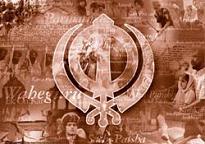 |
Sikh Missionary Society U.K. (Regd)
10, Featherstone Road.
Southall, Middx, U.K. UB2 5AA
Tel: +44 020 8574
1902
Fax: +44 020 8574
1912
Reg Charity No: 262404
|
|
|
| |
|
The Gurdwara (The Sikh Temple)
|
Notes on some Sikh Temples
Notes on some Sikh Temples: The Golden
Temple
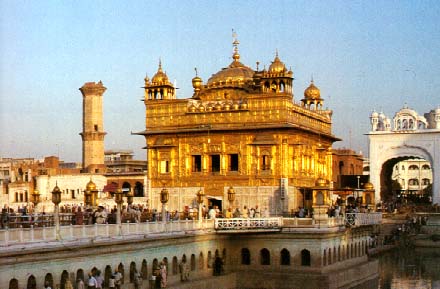 The Golden Temple. In 1577, Guru Ram Das asked his Sikhs to excavate a
spacious pool at a place in a jungle and later he founded the city of Ramdas
Pur (after his name). The city is now called Amritsar (Pool of immortality).
Guru Arjan later completed the brick work on the pool and built the Golden
Temple in the middle of the pool. Maharaja Ranjit Singh roofed the Temple
with gilded sheets of copper and thus the Temple previously called Harimandir
(The House of God) also came to be called 'The Golden Temple.' The Sikhs
also call it Darbar Sahib (The Guru's court) in reverence. The Holy Granth
is read day and night in the Temple by a relay of Granthis (readers). Over
the Deodhi (gateway to the Temple) is a treasury where lie four sets of
gold doors, jewelled canopies and umbrellas and the golden spades used
to dig the holy pool while the foundation was laid. Many other precious
relics can also be seen.
The Golden Temple. In 1577, Guru Ram Das asked his Sikhs to excavate a
spacious pool at a place in a jungle and later he founded the city of Ramdas
Pur (after his name). The city is now called Amritsar (Pool of immortality).
Guru Arjan later completed the brick work on the pool and built the Golden
Temple in the middle of the pool. Maharaja Ranjit Singh roofed the Temple
with gilded sheets of copper and thus the Temple previously called Harimandir
(The House of God) also came to be called 'The Golden Temple.' The Sikhs
also call it Darbar Sahib (The Guru's court) in reverence. The Holy Granth
is read day and night in the Temple by a relay of Granthis (readers). Over
the Deodhi (gateway to the Temple) is a treasury where lie four sets of
gold doors, jewelled canopies and umbrellas and the golden spades used
to dig the holy pool while the foundation was laid. Many other precious
relics can also be seen.
Return to the top of the page.
Notes on some Sikh Temples: The Akal Takhat
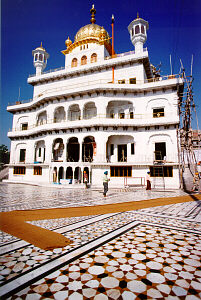 The Akal Takhat faces the Golden Temple and is opposite to the Golden Temple
gateway. It was built by Guru Hargobind. This has been the seat of political
and religious conferences of the Sikhs and all important decisions (Gurmattas)
are taken here. It houses the weapons and relics of the last five Gurus
and is one of the seats of authority of the Sikhs.
The Akal Takhat faces the Golden Temple and is opposite to the Golden Temple
gateway. It was built by Guru Hargobind. This has been the seat of political
and religious conferences of the Sikhs and all important decisions (Gurmattas)
are taken here. It houses the weapons and relics of the last five Gurus
and is one of the seats of authority of the Sikhs.
Return to the top of the page.
Notes on some Sikh Temples: Anand Pur
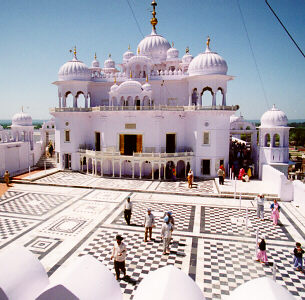 This temple was once a fortress built by Guru Gobind Singh and lies at
the foot of the Himalayas in a valley. The main part of this temple is
the Keshgarh, where Guru Gobind Singh instituted the Khalsa. Many of the
Guru's weapons can still be seen in this temple.
This temple was once a fortress built by Guru Gobind Singh and lies at
the foot of the Himalayas in a valley. The main part of this temple is
the Keshgarh, where Guru Gobind Singh instituted the Khalsa. Many of the
Guru's weapons can still be seen in this temple.
In the fortress is a well (Baoli) with 150 steps leading down to the
water. Near here is the Sisganj where the head of the ninth Guru was cremated
after it had been brought from Delhi by a faithful Sikh.
Return to the top of the page.
Notes on some Sikh Temples: Hazur Sahib
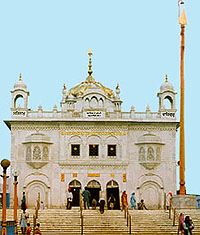 This temple was constructed by Maharaja Ranjit Singh at a place where Guru
Gobind Singh, the tenth Guru of the Sikhs ascended to heaven in 1708. It
is in Nander (Deccan) near the river Godavari. In its Toshakhana (treasury)
can be seen the weapons, jewellery, clothes, canopies and a small dagger
and gold tipped arrows of the Guru. Ever since the departure of the Guru
to his heavenly abode the Sikhs have kept a horse in the Guru's stable
like the one used by the Guru when he was alive. A bluish white horse can
still be seen there. A procession with the horse is taken out on the special
days commemorating the events in the Guru's life.
This temple was constructed by Maharaja Ranjit Singh at a place where Guru
Gobind Singh, the tenth Guru of the Sikhs ascended to heaven in 1708. It
is in Nander (Deccan) near the river Godavari. In its Toshakhana (treasury)
can be seen the weapons, jewellery, clothes, canopies and a small dagger
and gold tipped arrows of the Guru. Ever since the departure of the Guru
to his heavenly abode the Sikhs have kept a horse in the Guru's stable
like the one used by the Guru when he was alive. A bluish white horse can
still be seen there. A procession with the horse is taken out on the special
days commemorating the events in the Guru's life.
Return to the top of the page.
Notes on some Sikh Temples: Nankana Sahib
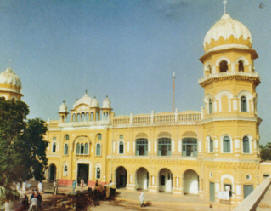 This temple is situated at a distance of 55 miles west of Lahore (Pakistan).
This is where Guru Nanak, the founder of Sikh religion was born and had
spent his early days. There are many other Gurudwaras in Nanakana Sahib
commemorating various events of the Guru's life. In an under- ground cellar
of the Janam Asthan (birth place) lie the bones of the martyrs who sacrificed
their lives to free the Gurudwaras from a corrupt priest Narian Das in
1921. Some of the crusaders were cut limb by limb, others were burnt alive
and their leader was tied to a Jand tree with his feet up and head downwards
and was roasted in that position by lighting fire beneath him. The half
burnt Jand tree still survives to tell the woeful tale.
This temple is situated at a distance of 55 miles west of Lahore (Pakistan).
This is where Guru Nanak, the founder of Sikh religion was born and had
spent his early days. There are many other Gurudwaras in Nanakana Sahib
commemorating various events of the Guru's life. In an under- ground cellar
of the Janam Asthan (birth place) lie the bones of the martyrs who sacrificed
their lives to free the Gurudwaras from a corrupt priest Narian Das in
1921. Some of the crusaders were cut limb by limb, others were burnt alive
and their leader was tied to a Jand tree with his feet up and head downwards
and was roasted in that position by lighting fire beneath him. The half
burnt Jand tree still survives to tell the woeful tale.
Return to the top of the page.
Management
The management of the Gurudwaras rests in the hands of an elected Committee.
The members of the Committee are elected out of the Sangat, and all adult
Sikhs, whether male or female, have the right to vote. Women are also elected
to the Committees and have equal rights. The election of the historic Sikh
Temples in India usually takes place every four years under Government
supervision. In England each Sikh Temple has its own constitution and more
or less the same method of election and management. Elections in England
usually take place annually.
Return to the top of the page.
Copyright (©)2004 by Sikh Missionary Society (U.K.)
All Rights Reserved.






